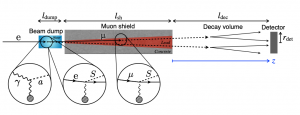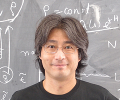
From “Search for new light particles at ILC main beam dump” by Yasuhito Sakaki and Daiki Ueda (arXiv:2009.13790)
Hitoshi Murayama asks you and the wider community to propose the experiment you’ve always dreamt of doing.
There is international consensus that an electron-positron Higgs factory should be the highest-priority next collider, and the International Linear Collider is the most mature and time-ready Higgs factory. But the ILC can and should be much more than a Higgs factory.
As the ILC is a multipurpose machine, many of the research possibilities it offers have been discussed already. Recently, more and more opportunities are being proposed: It can host beam dump experiments, fixed-target experiments with extracted beams, and studies near the interaction point detectors. The linear design allows for energy upgrades by extending the accelerator and/or by new accelerating schemes. There have been few studies about these opportunities so far. This article is a call to the wider particle physics (and possibly nuclear and condensed matter) community to think about how to exploit the ILC facility to its full potential beyond an e+e- Higgs factory.
‘ILC++’ is the title of the talk I gave at the Americas Workshop on Linear Colliders, where I started initial discussions on physics opportunities beyond the Higgs factory. The ILC will be a powerful facility with high-energy, high-intensity, high-quality beams of electrons and positrons. Unlike circular machines, each beam must be dumped with every collision, resulting in on the order of 1021 high-energy electrons dumped every year. Why not use these postcollision beams as well? There is a similar experiment called SHiP at CERN looking for relatively light and weakly coupled particles such as dark photon or axions.
Near the collision point, we could build small cavities along the beam direction (similar to the FASER experiment at the LHC) or away from the beam direction (similar to MATHULSA experiment at the LHC) looking for long-lived particles. There are many beam extraction points in the baseline design of the linac, where the beam can be extracted for fixed-target experiments such as the Light Dark Matter eXperiment. Obviously the beam energy is not as high as the LHC beam, but some new physics may be coupled primarily to electrons and photons (leptophilic). Extra excavation, if carried out at the same time as the main tunnel, would require minimum extra cost, while it becomes much more expensive later on. If we want to make use of such opportunities, we should plan now before the civil engineering design is frozen. A FASER-like detector costs about 1 million U.S. dollars or so. This is the time for out-of-box thinking.
Energy upgrades look more and more promising. The ILC is designed to allow for energy up to 1 teraelectronvolt. Compared to the ILC baseline of 35 megavolts per metre (MV/m), already the nitrogen infusion shows great promise for improved acceleration gradient up to 45 MV/m. New shapes of cavities called low-surface field (LSF) cavities are reaching 50 MV/m. The niobium-tin alloy Nb3Sn in principle allows acceleration gradients up to 120 MV/m, allowing upgrades up to 3-4 TeV in the same ILC tunnel. If we replace the whole accelerator by CLIC, with its different collider technology which is already quite mature, 3 TeV is already in sight. Future plasma or dielectric laser accelerators may bring it up to 30 TeV.
We are planning for two workshops in 2021. The first one is the traditional LCWS in Europe, sometime in March or the first half of April. The other is a dedicated workshop for experimentation at the ILC for collider, beam dump design, fixed-target studies, and detectors near but not at the interaction point, and new technologies that should lead up to the Expression of Interest once the Pre-lab is in place. I hope many of you will join the excitement.
The ILC will be a long-term versatile facility. New ideas are welcome!


Recent Comments